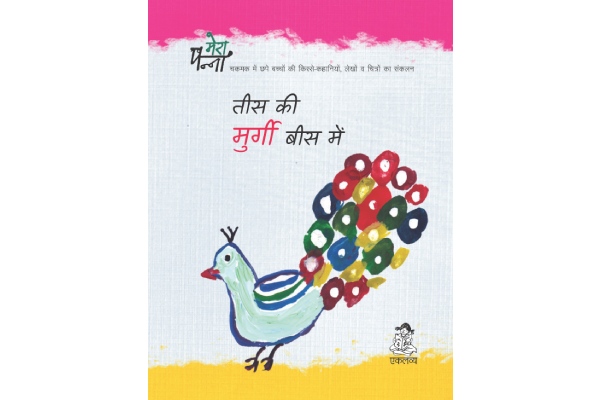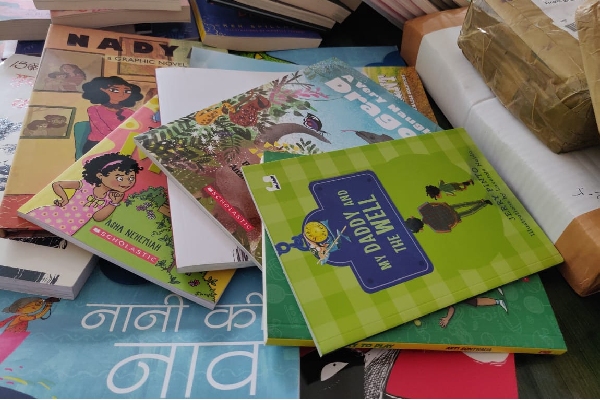
Loading...

Loading...
Rituparna is a professional social worker and a library educator with an experience of working with children, youth and women. They are passionate about storytelling and libraries. They are currently leading a library initiative, Kitape Katha Koi in Assam, through which they spread the joys of reading amongst children. They are particularly interested in starting conversations around non-normative genders and sexuality through books. Rituparna is an alumnus of Parag’s Library Educator’s Course and a recipient of PHL Book Box 2020. They are also a core member of the Free Library Network (FLN) India & South Asia and lead its North-East chapter.
Rainbow Girls and Rainbow Boys, is published by Pratham Books and supported by Parag Initiative of Tata Trusts, and its physical copies are available in five languages. It is written by Kamla Bhasin and illustrated by Priya Kuriyan. Kamla Bhasin was a feminist icon, poet, author and a pioneer of women’s rights movement in South Asia. Priya Kuriyan is an Indian illustrator, writer and animation filmmaker. She is the recipient of Parag’s Big Little Book Award 2019.
Parag’s Book Development team talked to Rituparna about Rainbow Girls and Rainbow Boys and the ways in which it is a book for everyone!
What is your relationship with your work around books, children and gender?
As a library educator, my identity as a queer intersectional feminist holds a significant position in my work. When I am taking books and stories to children, I don’t engage with them only as my audience. I think of myself as an individual reader, engaging with the children’s individuality. At the same time, in my library work, I also focus on placing myself, my conversations with children, and the stories we read in our social reality. My initiative, Project Kitape Katha Koi, is also based at the confluence of both the personal and social aspects of belongingness. As a library space, our strongest value is love. We welcome everyone here ‘moremere’, ‘pyar se’, ‘with love’. That is the foundation of my work- acceptance.
How did the book influence you emotionally?
Whenever I read a good children’s book, my first reaction is, “I wish I had read this as a child!”. It was the same with Rainbow Girls and Rainbow Boys. I felt secure and accepted. I felt I had found a companion for myself, and a path, a key to unlock closed doors around gender and sexuality. I was absolutely thrilled and I wrote to Kamla Di (she is always Kamla Di for me), to tell her how much I loved it. She asked me to translate it, and I did it in Asameese on Storyweaver. I then did a read aloud for my YouTube channel. It was a huge hit, and I received so many positive and happy responses from both adults and children. Many adults wrote to me saying that had they read this book as a child, they would not have bullied a classmate, or they would have felt more comfortable in their skin. Then, I went a step ahead. I bought a stock of this title, and gifted it to everyone, regardless of age and occasion. It is a lovely book. A book for everyone, really.
Why did you choose Rainbow Girls and Rainbow Boys to talk about gender and sexuality?
I am always on the lookout for books around gender and sexuality. It is an important topic for me, and for everyone else, for that matter. Some of the first books I found on gender were extremely rudimentary- they touched upon a single question, ‘Who is a boy and who is girl?’ Perhaps these conversations were important when these books were published, but they seemed irrelevant to me in today’s context, when there is a much deeper discourse around gender norms and sexuality. I was looking for a book which broke the normativity.
Rainbow Girls and Rainbow Boys allow me to ease difficult conversations around gender. One of the first sessions, where I used these books, was with the facilitators of a leading feminist grassroots organization in Assam. To start with a book about boys and girls, with different hairstyles, behaviors and dressing choices allowed me to create an increasingly open environment for discussion. The illustrations are beautiful and everyone can find themselves on at least one page. Once you know that the book accepts you as a person, you are also willing to accept other kinds of people that the book talks about. Conversations around non-binary genders, then, become much easier to initiate and navigate. This works for both children and adults. I have also seen this to be true in all settings- urban, semi-urban and rural.
How do you use the book with children? What conversations and activities do you plan around it?
Before I read the book in a session with children, we sit in a circle and talk about ourselves. We talk about where we are from and our likes and dislikes. Every child gets to speak. I tell them to imagine the room as a garden with a lot of different and colorful flowers. I tell them that all these flowers make the garden beautiful.
When we read the book, we pause on every page to look at the illustrations. Some of the questions I ask children are-
• Did you find yourselves in the book?
• Do you know anyone who looks like this?
• What do you think when you come across a person who looks like this?
• What do you do when you see a person who looks like this?
• What other kinds of people do you see around you?
• How are they different?
With these questions, we are not just able to have conversations around gender norms, but also around disability and poverty. Sometimes, I don’t even have to read the text. The illustrations are enough to steer the conversation.
Some of these conversations lead to drawing sessions with children. Often, they have thought of someone who resembles a character in the book and they want to draw that person and talk about them. Sometimes, we share our own experience of interacting with different kinds of people. I keep the activities and conversations open and fluid. For me, the book is a poem, and children can receive it the way they want to.
How do children respond to the books?
Conversations following this book are never too heavy with children. While we are reading, I can see that the children are actively thinking about themselves and other people in their families and neighborhoods, who look like the boys and girls in this book. “Mera dost aisa dikhta hai” (“My friend looks like this”), Meri dost apne papa ka kurta pehenti hai” (“My friend wears her father’s kurta”), are some enthusiastic responses I always get.
In some sessions with older children, we share our feelings and experiences. A participant in one of the sessions was able to share that he had to shave and keep a long pony tail after a family ritual, and his class had made fun of him. Everyone in the room understood his hurt. By the end of the book, children are much more empathetic in their responses. During the read-aloud, a couple of children were laughing about a person in their village who dresses up colorfully. By the end of the conversation, their response had changed to, ‘Vo colourful kapde pehenta hai to kya hua’ (How does it matter if he wears colorful clothes?”), or “Vo chote baal rakhti hai to kya hua” (“How does it matter if she keeps her hair short?”).
In another session, we were talking about nail paints. Many children in the group were of the view that it is not okay for boys to paint their nails. This was my cue. The next day, I did a read-aloud for Ranganna, the story about an elephant who wants to wear nail polish. After the read aloud, I gave everyone a set of different colored nail paints and asked them to paint each other’s nails. Everyone in the group was having fun choosing nail paints and painting different colors on each other’s hands. Three boys were reluctant to participate, so I let them be. After a while, when they saw they were missing out on all the fun, they went ahead and participated. By the end of it, they had a different color on each of their nails! I absolutely love it when I am able to get responses like these.
What are some other books you use in your sessions around gender?
There are some books which I use regularly. And Tango Makes Three is an actual story of two gay penguins in New York’s Central Zoo. That is one of my favorites. So are Oliver Button is a Sissy and The Story of Ferdinand, a Spanish classic about a bull who loves flowers! I also use Heather Has Two Mommies, In Our Mother’s House, The Why Why Girl, Guthli has Wings and Nadya. Malu Bhalu and Betiyaan Bhi Chahein Azadi[1] by Kamla Di are also books I use often.
I really feel that one can use most books and stories to talk about gender with children. People often ask me, “Why do you take such serious topics with children?” and my only answer to them is, “Because children are a part of this world. If they are unprepared for the realities, will they not be overwhelmed when they have to face it?”. I feel we can talk to children about everything- from mental health and environment, to human relationships and death. All it needs is a safe and inclusive space, where everyone can talk about their journeys and embark on new ones. As a library educator, I trust my children, and they trust me back. We are able to create a dialogue, build supportive relationships and engage in self-discoveries. Books like Rainbow Girls and Rainbow Boys speak the language of love. They say, “Whoever you are, we like you”. What more does one need?

बाल-साहित्य: किताबों की एक महत्वपूर्ण, अद्भुत और बढ़ती हुई श्रेणी
बच्चों की किताबें अभी भी पढ़ता रहा,कुछ पत्रिकाएँ भी,और इनके लिए कुछ कुछ लिखता भी रहा।…

क्यों ज़रूरी है बाल साहित्य की बेहतरीन किताबों की सूची
बच्चों के सामान्य और स्कूली जीवन में बाल साहित्य की अहमियत को सभी स्वीकारते हैं। बच्चों के चहुँमुखी व्यक्तित्व (समग्र) विकास में साहित्य की महत्त्वपूर्ण भूमिका होती है।…